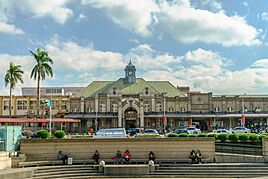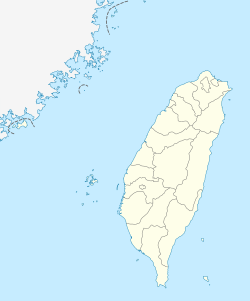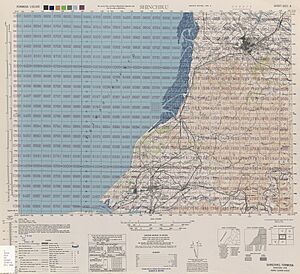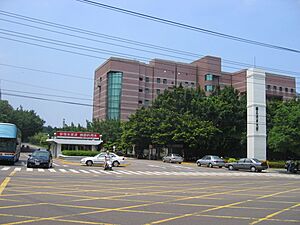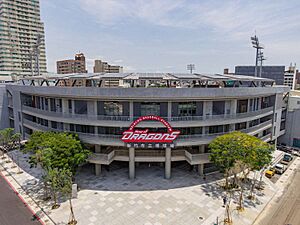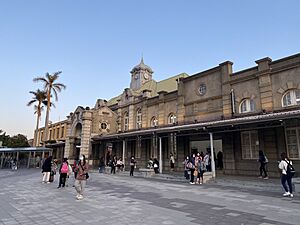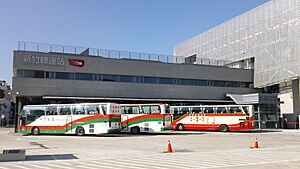Hsinchu facts for kids
Quick facts for kids
Hsinchu
新竹
Shinchiku (Japanese reading)
|
|||
|---|---|---|---|
|
City
|
|||
| Hsinchu City | |||
|
Clockwise from top: Hsinchu Railway Station, Hsinchu City Government Building, Hsinchu City East Gate, Hsinchu Chenghuang Temple, Hsinchu Zoo, Hsinchu City Moat Park, Hsinchu City Art Gallery and Reclamation Hall
|
|||
|
|||
| Nickname(s):
Windy City (風城) or Chu City (竹市)
|
|||
 |
|||
| Country | |||
| Province | Taiwan Province (government suspended) | ||
| Region | Northern Taiwan | ||
| First mentioned as Tek-kham | 1626 | ||
| City established | 1711 | ||
| Renamed to Hsinchu | 1878 | ||
| Part of Shinchiku Prefecture | 17 April 1895 | ||
| Reconstituted as a provincial city | 9 November 1945 | ||
| Demoted to county-administered city within Hsinchu County | 1 December 1951 | ||
| Provincial city status restored | 1 July 1982 | ||
| Seat | North District | ||
| Districts |
3 districts
East
North Xiangshan |
||
| Government | |||
| • Body |
|
||
| Area | |||
| • Total | 104.15 km2 (40.21 sq mi) | ||
| Area rank | 20 out of 22 | ||
| Population
(March 2023)
|
|||
| • Total | 453,536 | ||
| • Rank | 15 of 22 | ||
| • Density | 4,354.64/km2 (11,278.5/sq mi) | ||
| Time zone | UTC+8 (National Standard Time) | ||
| Postal code |
300
|
||
| Area code(s) | (0)3 | ||
| ISO 3166 code | TW-HSZ | ||
| Bird | Eurasian magpie (Pica pica) | ||
| Flower | Azalea | ||
| Hsinchu | |||||||||||||||||||||||||||||||
|---|---|---|---|---|---|---|---|---|---|---|---|---|---|---|---|---|---|---|---|---|---|---|---|---|---|---|---|---|---|---|---|
| Chinese name | |||||||||||||||||||||||||||||||
| Chinese | 新竹 | ||||||||||||||||||||||||||||||
| Literal meaning | New Bamboo | ||||||||||||||||||||||||||||||
|
|||||||||||||||||||||||||||||||
| Japanese name | |||||||||||||||||||||||||||||||
| Kanji | 新竹 | ||||||||||||||||||||||||||||||
| Hiragana | しんちく | ||||||||||||||||||||||||||||||
| Katakana | シンチク | ||||||||||||||||||||||||||||||
|
|||||||||||||||||||||||||||||||
| Former names | |||||||||||||||||||
|---|---|---|---|---|---|---|---|---|---|---|---|---|---|---|---|---|---|---|---|
| Zhuqian | |||||||||||||||||||
| Traditional Chinese | 竹塹 | ||||||||||||||||||
| Literal meaning | Bamboo natural barrier | ||||||||||||||||||
|
|||||||||||||||||||
| Nicknames | |||||||||||||||||||||
|---|---|---|---|---|---|---|---|---|---|---|---|---|---|---|---|---|---|---|---|---|---|
| Windy City | |||||||||||||||||||||
| Traditional Chinese | 風城 | ||||||||||||||||||||
|
|||||||||||||||||||||
Hsinchu (Chinese: 新竹; pinyin: Xīnzhú) is a large city in northwestern Taiwan. It has about 450,000 people, making it one of the most populated cities in Taiwan. Hsinchu is on the coast, next to the Taiwan Strait in the west. It borders Hsinchu County to the north and east, and Miaoli County to the south. People call Hsinchu the Windy City because of the strong winds it gets in autumn and winter.
Long ago, native groups lived in this area. Later, settlers from China arrived and called the place "Tek-kham." The city was officially started by Han Chinese settlers in 1711. It was renamed "Hsinchu" in 1878. When Japan ruled Taiwan, the city was called "Shinchiku."
In 1980, the Taiwanese government built the Hsinchu Science Park. This park is a major center for making computer chips (semiconductors). Big companies like TSMC, MediaTek, and United Microelectronics Corporation have their main offices here.
Hsinchu is also important for its culture. The Chenghuang Temple of Hsinchu, built in 1747, is a popular place for prayer. You can also find important universities here, like National Yang Ming Chiao Tung University and National Tsing Hua University.
Contents
- What's in a Name? Hsinchu's Meaning
- Hsinchu's Story: A Look at Its Past
- Hsinchu's Location and Weather
- Hsinchu's Economy: A Tech Hub
- Learning in Hsinchu: Schools and Universities
- Fun Places to Visit in Hsinchu
- Sports in Hsinchu
- Getting Around Hsinchu
- Famous People from Hsinchu
- Hsinchu's Friends Around the World
- See also
What's in a Name? Hsinchu's Meaning
The name Hsinchu comes from the Chinese words for "New Bamboo." It's pronounced Xīnzhú in Mandarin Chinese.
The city's older name was Tek-chhàm. This name meant "bamboo barrier." It might also have come from an old native word meaning "Seashore."
Hsinchu is often called "The Windy City" because of its strong winds. It's also known as "The Garden City of Culture and Technology" by its tourism group.
Hsinchu's Story: A Look at Its Past
Early Days: First Settlements
The Taokas, a native group, lived in the Hsinchu area a long time ago. In the 1600s, Catholic missionaries from Spain visited the settlement of Tek-kham. Later, the Dutch took control of the area.
Qing Dynasty Rule: Chinese Influence
Under the Qing Dynasty, Chinese settlers built a town at Tek-kham in 1711. A man named Wang Shih-chieh led over 180 people from Kinmen to settle here.
In 1878, Tek-kham became a county and was renamed Xinzhu, or Hsinchu. When Taiwan became a province in 1887, Hsinchu was part of Taipeh Prefecture.
Japanese Rule: Shinchiku Era
During the time Japan ruled Taiwan, the city was called Shinchiku. It was one of the most populated cities. In 1904, it was the 7th largest city. Shinchiku became a town in 1920 and a city in 1930. It was also the main city for the Shinchiku Prefecture.
Republic of China: Modern Hsinchu
After Japan's rule ended in 1945, the Republic of China government took over. Hsinchu became a "provincial city." This meant it was an important city directly managed by the province.
In 1982, more areas, like Xiangshan Township, joined Hsinchu City. The city government grew and added new departments to serve its people.
Since 2021, there's been a discussion about making Hsinchu City and Hsinchu County into a "special municipality." This would give them more power and importance, like other big cities in Taiwan.
Hsinchu's Location and Weather
The city is surrounded by Hsinchu County to the north and east. To the south is Miaoli County, and to the west is the Taiwan Strait.
Climate: Windy and Rainy Seasons
Hsinchu has a humid subtropical climate. This means it has hot, humid summers and mild winters. The rainy season is from February to September, with the most rain from April to August. May and early June also bring heavy "plum rains."
From June to September, the weather is hot and humid. October to December are often the nicest months. Hsinchu gets strong easterly winds from the East China Sea. Like many places in Taiwan, it can experience typhoons and earthquakes.
| Climate data for Hsinchu City (1991–2020 normals, extremes 1938–present) | |||||||||||||
|---|---|---|---|---|---|---|---|---|---|---|---|---|---|
| Month | Jan | Feb | Mar | Apr | May | Jun | Jul | Aug | Sep | Oct | Nov | Dec | Year |
| Record high °C (°F) | 30.3 (86.5) |
30.6 (87.1) |
33.8 (92.8) |
34.1 (93.4) |
35.5 (95.9) |
37.4 (99.3) |
38.0 (100.4) |
39.4 (102.9) |
38.8 (101.8) |
37.9 (100.2) |
34.4 (93.9) |
31.1 (88.0) |
39.4 (102.9) |
| Mean daily maximum °C (°F) | 19.1 (66.4) |
19.4 (66.9) |
21.6 (70.9) |
25.6 (78.1) |
28.9 (84.0) |
31.5 (88.7) |
33.2 (91.8) |
32.8 (91.0) |
31.2 (88.2) |
28.0 (82.4) |
25.1 (77.2) |
21.1 (70.0) |
26.5 (79.6) |
| Daily mean °C (°F) | 15.7 (60.3) |
16.0 (60.8) |
18.0 (64.4) |
21.9 (71.4) |
25.2 (77.4) |
27.9 (82.2) |
29.3 (84.7) |
28.9 (84.0) |
27.3 (81.1) |
24.4 (75.9) |
21.5 (70.7) |
17.7 (63.9) |
22.8 (73.1) |
| Mean daily minimum °C (°F) | 13.1 (55.6) |
13.4 (56.1) |
15.2 (59.4) |
18.9 (66.0) |
22.2 (72.0) |
24.9 (76.8) |
26.0 (78.8) |
25.8 (78.4) |
24.4 (75.9) |
21.8 (71.2) |
18.8 (65.8) |
15.1 (59.2) |
20 (68) |
| Record low °C (°F) | −0.1 (31.8) |
3.5 (38.3) |
3.4 (38.1) |
4.9 (40.8) |
11.7 (53.1) |
14.7 (58.5) |
20.2 (68.4) |
18.9 (66.0) |
14.7 (58.5) |
9.5 (49.1) |
6.6 (43.9) |
4.0 (39.2) |
−0.1 (31.8) |
| Average precipitation mm (inches) | 75.7 (2.98) |
123.0 (4.84) |
159.8 (6.29) |
161.9 (6.37) |
249.0 (9.80) |
252.0 (9.92) |
120.2 (4.73) |
197.1 (7.76) |
174.5 (6.87) |
53.6 (2.11) |
51.1 (2.01) |
57.7 (2.27) |
1,675.6 (65.95) |
| Average precipitation days (≥ 0.1 mm) | 9.8 | 11.3 | 13.5 | 12.7 | 12.0 | 10.6 | 7.9 | 10.7 | 8.9 | 5.5 | 6.8 | 8.0 | 117.7 |
| Average relative humidity (%) | 78.3 | 80.4 | 79.6 | 78.4 | 78.1 | 77.0 | 74.3 | 75.9 | 74.5 | 73.8 | 75.5 | 76.3 | 76.8 |
| Mean monthly sunshine hours | 106.7 | 91.0 | 101.0 | 111.6 | 145.4 | 185.0 | 240.6 | 209.7 | 193.5 | 190.0 | 144.8 | 126.1 | 1,845.4 |
| Source: Central Weather Bureau | |||||||||||||
Hsinchu's Economy: A Tech Hub
The Hsinchu Science Park is home to about 360 companies. Its main goal is to bring high-tech businesses to Taiwan. The government has invested a lot of money to support this park.
The park is famous for its semiconductor and electronics companies. These companies make computer chips and other electronic parts. In 2020, Hsinchu was recognized as an important "global city" for its economic role.
Learning in Hsinchu: Schools and Universities
Hsinchu City is a big center for education in northern Taiwan. It has six universities, including two very important ones: National Yang Ming Chiao Tung University and National Tsing Hua University.
The city also has many other schools:
- 33 elementary schools
- 19 middle schools
- 12 high schools
International Schools
- Pacific American School
- Hsinchu International School
- Hsinchu American School
High Schools
- National Experimental High School
- National Hsinchu Senior High School
- National Hsinchu Girls' Senior High School
- Hsinchu Kuang-Fu Senior High School
Universities
- National Yang Ming Chiao Tung University
- National Tsing Hua University
- Chung Hua University
- Hsuan Chuang University
- Yuanpei University of Medical Technology
- National Hsinchu University of Education
Fun Places to Visit in Hsinchu
Hsinchu has many interesting places for visitors:
- Aqueduct Museum of Hsinchu City
- Black Bat Squadron Memorial Hall
- Chenghuang Temple of Hsinchu
- Glass Museum of Hsinchu City
- Hsinchu City Art Site of Railway Warehouse
- Hsinchu CKS Baseball Stadium
- Hsinchu Museum of Military Dependents Village
- Hsinchu Fish Harbor
- Hsinchu Zoo
- National Hsinchu Living Arts Center
- 17 Kilometer Coastal Scenic Area
- Green Grass Lake
- Chenghuang Temple Night Market – This market has many food stalls that have been around for over 50 years. You can try famous snacks like Hsinchu meatballs, spring rolls, and rice noodles.
- Neiwan Old Street – Here you'll find traditional Hakka restaurants. They serve special dishes like ginger-lily-flavored glutinous rice dumplings and Hakka tea.
Sports in Hsinchu
Hsinchu is home to a professional baseball team called the Wei Chuan Dragons. They play in Taiwan's Chinese Professional Baseball League.
Hsinchu has also hosted big sports events, including:
- 1997 World Youth Baseball Championship
- 2005 BWF Para-Badminton World Championships
Getting Around Hsinchu
Trains
The main train station is Hsinchu railway station. There are also smaller stations on the Western Trunk line and the Neiwan line. For faster travel, you can use the High Speed Rail station in nearby Zhubei, Hsinchu County.
Cycling
Hsinchu City has many cycling paths, which are great for bike rides. There are also many cycling clubs in the city.
Seaports
There are fishing ports at Nanliao and Haishan.
Airport
Hsinchu Airport is mainly used as a military airbase. The closest airport for international flights is Taoyuan International Airport, which is about 58 km away.
Famous People from Hsinchu
- Chi Cheng: An Olympic medalist in track and field from 1968.
- Yuan T. Lee: Won the Nobel Prize in Chemistry in 1986.
- Hsieh Su-Wei: A Taiwanese tennis player who was once ranked number one in doubles worldwide.
- Hebe Tien: A popular solo singer and a member of the group S.H.E.
- Cyndi Wang: A well-known singer.
- Wen Shang-Yi: The guitarist and leader of the band Mayday.
Hsinchu's Friends Around the World
Hsinchu has "sister cities" or "twin towns" in different countries. These are cities that have special friendly relationships.
| City | Region | Country | Since |
|---|---|---|---|
| Beaverton | Oregon | 1988 | |
| Cary | North Carolina | 1993 | |
| Cupertino | California | 1998 | |
| Richland | Washington | 1988 | |
| Plano | Texas | 2003 | |
| Okayama | Okayama Prefecture | 2003 | |
| Puerto Princesa | Palawan | 2006 | |
| Fairfield | New South Wales | 1994 | |
| Chiayi City | Taiwan | 2002 | |
| Airai | Airai | 2011 |
See also
 In Spanish: Hsinchu para niños
In Spanish: Hsinchu para niños


